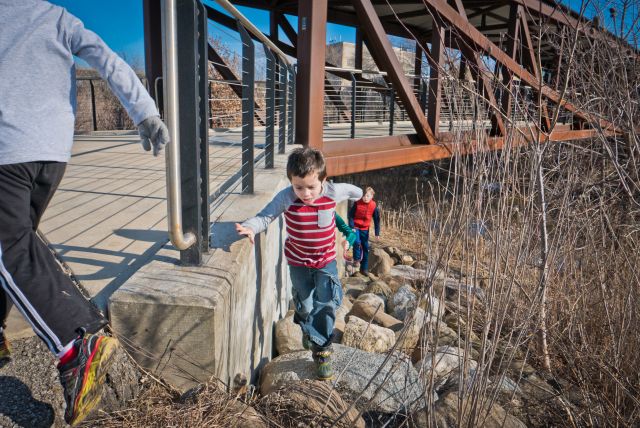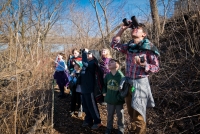I enter the building and hear silence as I am first to arrive today, but soon it's humming with the sounds of excited school children. We are learning about the seasons, specifically winter. After introducing the seasons with a puppet show and winter dance we head out to explore. At first you might not think there would be much to discover on this recently developed park, but soon it becomes apparent there is more to see here than meets the eye – or nose!
The students discover a dead skunk not by sight, but by scent. How it died, only the owl knows. However it left this planet, one thing it did not take with it was its distinct odor. To some this smell can be a distraction or a nuisance, but today it was a highlight – I don’t encounter many who don’t already know the smell of skunk, even K5 students. They are fascinated with how this black and white creature left this world, but even more curious as to why it smells so. I make sure to ease any fears of them getting sprayed as it takes a lot for a skunk to spray. Even when my dog charged a skunk within 10 feet it stood its ground by pounding its fists against the earth. My dog quickly turned around as she must have remembered the last time she harassed one.
Our adventure (I say adventure because anywhere you are in the world can be an adventure, you just have to make it so) takes us across one of three bridges where we drop sticks and throw rocks. Something this simple is so captivating to a young mind, and I guess I still have a young mind because I cannot help myself from joining in on the rock throwing.

As the students race forward and meet me at the dragonfly rock sculpture, I’m running right with them, mirroring the huge smiles of joy on their faces. When kids run they smile and when adults run it frees up the mind. We carefully balance our way across the rocks and drop into a bioswale.
This takes us into another habitat and mini-world, one filled with mystery and intrigue. They are so excited to explore and just be outside that they almost miss all the holes dug into the sides of the hills. Literally there are over 10 tiny doors into the underground world. We stop to explore one and discover someone has had a nice meal. Feathers are scattered about but no bones. Who could have feasted here is a mystery to this day, but our Community Science team will soon find out by placing wildlife cameras. Knowing that an animal ate a meal here was all the students needed to fill their curious minds and fuel more exploration.
Climbing the mountain out of the bioswale brings us under the 35th Street viaduct and to another adventure – huge piles of woodchips. Nothing special to the untrained eye, but to me it means climbing adventures! I am always amazed at how simple going outside with students can be as we spend a good 30 minutes running the obstacle courses we imagine in our minds.
But the adventures don't stop there! On our way back to the bus we discover a few creatures just coming out of a long winter slumber. A toad has been washed out of hiding by an early spring storm. This thin amphibian is trying to make its way through last years flowers and grasses, looking for a meal I assume. I know I would after a long winter frozen under the ground. A snake was also sunning itself as it too had just come out of hiding in the recent days.
The more we looked that day the more we saw, such a diverse array of animals and plants occupying this now rehabilitated piece of land. The valley started as a marsh, then into industrial zone that fueled Milwaukee’s growth, and now it is a combination of both. The Menomonee Valley is a perfect example of how we can manipulate the land for both humankind and the natural world. Come spend some time in the valley, whether by bike or foot and I guarantee you will discover a world filled with many treasures.





